Search the Blog
Categories
- Books & Reading
- Broadband Buzz
- Census
- Education & Training
- General
- Grants
- Information Resources
- Library Management
- Nebraska Center for the Book
- Nebraska Memories
- Now hiring @ your library
- Preservation
- Pretty Sweet Tech
- Programming
- Public Library Boards of Trustees
- Public Relations
- Talking Book & Braille Service (TBBS)
- Technology
- Uncategorized
- What's Up Doc / Govdocs
- Youth Services
Archives
Subscribe
Category Archives: Information Resources
The Data Dude: Digital Inclusion Survey Update
 Many of you are familiar or participated in last year’s digital inclusion survey. For those of you who might be new and have not heard about this, please check it out. Now the website can be a bit difficult to navigate, so let’s try and point out a couple of valuable things. While it is certainly encouraged to browse around the site, a good starting point is the interactive map. Recently, the digital inclusion people put a note towards the top of the mapping tool indicating a number of changes to the data, various “enhancements”, and the ability for you to update your own data. The easiest way to get started is to scroll down on the map page to the actual map, and directly above the map is a search box (called library lookup) for your library name (keep in mind that this is the name of the library, not necessarily your city). You can also use one of the draw tools to select a custom area on the map. Once you locate your library from the library lookup feature, the search will retrieve a map on the left and various folders on the right that summarize the following areas (with data pulled from census): Demographics, Economics, Education, Health, and Survey. While this is the same stuff you can get from Census, arguably this might be a more decent starting point or overview of data to better know your library service area. One other thing worth mentioning is that if you click on the map marker for your library you will get a pop-up that summaries the specific digital inclusion data for your library (or library branch). This includes the number of public access computers, broadband speed, technology services/resources, training, and programs/assistance. Underneath the google map photo on the left side of this pop-up, you can change the demographic radius (from 1, 3, 5, or 10 miles), export a summary profile of your library to a PDF (e.g. to hand out to board members, local policy makers, or members of the community), or edit your survey information. If things have changed, please update your information so that the maps are kept up to date. You can do this by clicking on the “Edit Branch & Survey Info” bar (again, just below the google map photo of your library, or the street in front of your library). Shaka.
Many of you are familiar or participated in last year’s digital inclusion survey. For those of you who might be new and have not heard about this, please check it out. Now the website can be a bit difficult to navigate, so let’s try and point out a couple of valuable things. While it is certainly encouraged to browse around the site, a good starting point is the interactive map. Recently, the digital inclusion people put a note towards the top of the mapping tool indicating a number of changes to the data, various “enhancements”, and the ability for you to update your own data. The easiest way to get started is to scroll down on the map page to the actual map, and directly above the map is a search box (called library lookup) for your library name (keep in mind that this is the name of the library, not necessarily your city). You can also use one of the draw tools to select a custom area on the map. Once you locate your library from the library lookup feature, the search will retrieve a map on the left and various folders on the right that summarize the following areas (with data pulled from census): Demographics, Economics, Education, Health, and Survey. While this is the same stuff you can get from Census, arguably this might be a more decent starting point or overview of data to better know your library service area. One other thing worth mentioning is that if you click on the map marker for your library you will get a pop-up that summaries the specific digital inclusion data for your library (or library branch). This includes the number of public access computers, broadband speed, technology services/resources, training, and programs/assistance. Underneath the google map photo on the left side of this pop-up, you can change the demographic radius (from 1, 3, 5, or 10 miles), export a summary profile of your library to a PDF (e.g. to hand out to board members, local policy makers, or members of the community), or edit your survey information. If things have changed, please update your information so that the maps are kept up to date. You can do this by clicking on the “Edit Branch & Survey Info” bar (again, just below the google map photo of your library, or the street in front of your library). Shaka.
Public Libraries Able to Access Nebraska Supreme Court and Court of Appeals Opinions Through Public Website
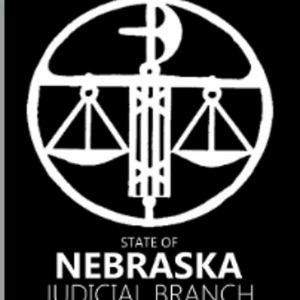 Free online access to the official published judicial opinions of the Nebraska Supreme Court and Nebraska Court of Appeals will be available to the public beginning January 1, 2016.
Free online access to the official published judicial opinions of the Nebraska Supreme Court and Nebraska Court of Appeals will be available to the public beginning January 1, 2016.
Text-searchable opinions dating back to 1871 will be available for the Nebraska Supreme Court. The full collection of opinions of the Nebraska Court of Appeals, beginning with its establishment in 1992, will also be offered.
Previously, appellate court opinions were printed or were available online through various for-profit subscription services. All published opinions will be provided via the Nebraska Appellate Courts Online Library at ne.gov/go/opinions. Once printing of judicial opinions in the Nebraska Advance Sheets and the Decisions of the Nebraska Court of Appeals ceases in June 2016, opinions will be available exclusively online.
Newly released opinions of both courts will continue to be available for 90 days on the Nebraska Judicial Branch Web site at https://supremecourt.nebraska.gov/ and from the Clerk of the Supreme Court and Court of Appeals upon request, and from any electronic provider of legal information choosing to provide them.
Official opinions in the online library will be accessible 24/7 using smart phones, tablets or computers from anywhere with Internet access. Access via the online library allows the appellate courts to make their judicial opinions more easily available to the public.
The Data Dude on Line Charts, Pt. 2
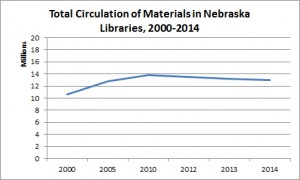
 Last week, in response to some data about paper book holdings in Nebraska libraries, the Dude asked the question: So what? Today will be an attempt to provide some context. If we look at the title to last week’s NET line graph, Bill Kelly added the following label to the top of the graph: SHELF LIFE: Fewer Library Books, and of course the assumption is that libraries have fewer paper books, presumably in response to less demand, and more eBooks. And over the time period in the NET graph (2010-2014) that’s true. But as was mentioned last week, if the data is expanded back to 2000, there was an actual increase of 1.19% in paper book holdings in Nebraska libraries during those 14 years, but the trend over the past few years is in fact lower amounts of physical items and increased amounts of electronic items in libraries.
Last week, in response to some data about paper book holdings in Nebraska libraries, the Dude asked the question: So what? Today will be an attempt to provide some context. If we look at the title to last week’s NET line graph, Bill Kelly added the following label to the top of the graph: SHELF LIFE: Fewer Library Books, and of course the assumption is that libraries have fewer paper books, presumably in response to less demand, and more eBooks. And over the time period in the NET graph (2010-2014) that’s true. But as was mentioned last week, if the data is expanded back to 2000, there was an actual increase of 1.19% in paper book holdings in Nebraska libraries during those 14 years, but the trend over the past few years is in fact lower amounts of physical items and increased amounts of electronic items in libraries.
The eBook conundrum is a difficult one, and analyzing data for library holdings of eBooks is hard to illustrate. Why? Well, a few reasons, including the fact that eBooks aren’t technically purchased by libraries, they are leased. And those lease terms vary by publisher (both the duration and the price). Some publishers still don’t make electronic copies of their books available to libraries at all. Perhaps that is the deeper story to something like SHELF LIFE: Fewer Library Books; namely how the eBook lending platforms for libraries are much different than the traditional right of first sale traditional paper model. Notwithstanding all of this, it might be more productive to look at trends about the actual use of the items in the library collection. And even that might be misleading; a library could contain a bunch of crap that no one wants to check out, but for one reason or another has never been weeded. When a new go-getter takes over the library, perhaps all this lower demand stuff gets weeded and replaced with stuff that actually will be used. The end result to that would be lower numbers of paper books and VHS tapes (assuming those are the ones that would be weeded), and increased circulation of other things like light sabers and power tools. The chart, above right, demonstrates the total circulation of items in Nebraska over the last 14 years (incidentally, while the one above has the Y-axis at zero, it doesn’t look remarkably different when the Y-axis is started at 5 million).
The reality is that overall in the state, circulation of electronic items went up about 80% from 2012-2014, and circulation of physical items declined 6.42% during the same time period. Much of this is due to the fact that more libraries got involved in consortia (such as Nebraska OverDrive) that allowed more communities (and thus overall more people) to access materials. Keep in mind that, notwithstanding the recent decline of physical items held by Nebraska libraries, over 12 million physical items did circulate in 2014 (more than 15 times the number of electronic items used). Therefore, when looking at these numbers, many times the debate is framed as an either/or proposition when it comes to the physical and electronic in libraries (such as part 5 of the NET series – Will a Nebraska Community Tech Center Force Us To Consider Libraries Without Books?) and ultimately that’s probably not the question to ask (at least the data doesn’t support it).
In actuality, libraries are offering new things and expanding services in addition to offering the traditional ones. As the chart second from the top illustrates, program attendance has gone up during the 2000-2014 time period. Additionally, the number of programs offered has risen at a rate fairly consistent with program attendance, and annual library visits have remained fairly steady for a number of years at around 8 million per year. The real questions (and the NET series tackled some of these) are how libraries are adapting to meet the needs of the community, by either expanding the offering of things in the collection, programs, and spaces (which admittedly is broad ranging, and could mean things like meeting rooms, community learning spaces, or collaborative makerspaces). And that is why the real question should be framed by an “and” instead of an “or”. Shaka.
New Makerspace Page!
Check out the Nebraska Library Commission’s newest page: Creative, Innovative, and MakerSpaces in Nebraska! Here we list Nebraska libraries that have purchased 3D printers, as well as public and private “creative spaces” throughout the state – places you can visit to take classes, work with technology, make art, write poetry – whatever your creative outlet, we want to help you find a space for it!
This page is a work-in-progress and will be constantly updated as we discover more resources. If you have, or know of, a space we have not listed, please contact the Information Services Team.
Posted in General, Information Resources
2 Comments
NCompass Live: What is NebraskAccess?
 Join us for next week’s NCompass Live, “What is NebraskAccess?”, on Wednesday, Dec. 9, 10:00-11:00 am Central Time.
Join us for next week’s NCompass Live, “What is NebraskAccess?”, on Wednesday, Dec. 9, 10:00-11:00 am Central Time.
What is NebraskAccess?
A) It’s a website!
B) It’s a subject directory of websites selected by librarians!
C) It’s the Nebraska Library Commission statewide database program!
D) All of the above!
NebraskAccess has been around in one form or another for a number of years (NLC started purchasing statewide access to databases on behalf of Nebraska libraries and residents in 1998). Many of us in the Nebraska library community have been around a long time too – which makes it tempting to assume that EVERYONE knows what NebraskAccess is. We know that’s not the case though. Every year we run in to librarians who just entered the profession or just moved to the state and DON’T know about NebraskAccess. This session is for them (and any of you who’ve been around for a while but want a refresher)! Join Allana Novotny and Susan Knisely as they address fundamental questions like: What is NebraskAccess? How can my library participate? Who pays for it? How do my patrons access it? What databases are included? How do I stay informed? And more.
Upcoming NCompass Live events:
- Dec. 16 – Tech Tuesdays: Taking Time to Teach Technology to Technophobes
- Dec. 23 – Best New Teen Books of 2015
- Jan. 6, 2016 – Best New Children’s Books of 2015
- Jan. 20, 2016 – Moving to Windows 10
- Jan. 27, 2016 – One Book, One School, One Community – Experiences with all-school reads
For more information, to register for NCompass Live, or to listen to recordings of past events, go to the NCompass Live webpage.
NCompass Live is broadcast live every Wednesday from 10am – 11am Central Time. Convert to your time zone on the Official U.S. Time website. The show is presented online using the GoToWebinar online meeting service. Before you attend a session, please see the NLC Online Sessions webpage for detailed information about GoToWebinar, including system requirements, firewall permissions, and equipment requirements for computer speakers and microphones.
Free Resources Seminar to start and grow your small business
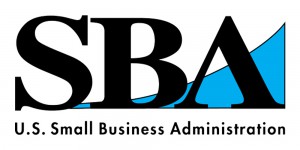 Do you have a great idea for a business but just don’t know where to begin? Knowing where to go to get help is crucial to starting and/or growing your small business. In this seminar, you will learn about a variety of free and low-cost resources to help you: write your business plan, find training opportunities, receive small business counseling and mentorship, obtain legal guidance, learn about networking opportunities, benefit from free online education, and learn about all kinds of other resources.
Do you have a great idea for a business but just don’t know where to begin? Knowing where to go to get help is crucial to starting and/or growing your small business. In this seminar, you will learn about a variety of free and low-cost resources to help you: write your business plan, find training opportunities, receive small business counseling and mentorship, obtain legal guidance, learn about networking opportunities, benefit from free online education, and learn about all kinds of other resources.
Free resources include SCORE, the Nebraska Business Development Center and REAP’s Women’s Business Center.
Greater Omaha Chamber of Commerce
1301 Harney Street, Omaha, Neb.
Tuesday, Dec 8th from 12-1 p.m.
Email elizabeth.yearwood@sba.gov to register
The Data Dude on Line Charts, Pt. 1

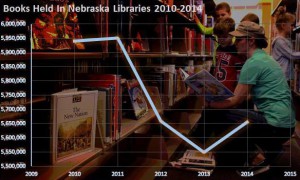
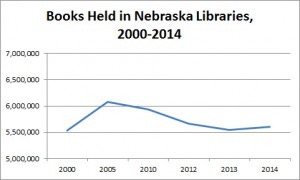
 Today’s post will focus on line charts (or graphs, if you prefer). The Dude thought about this in response to the graph (second from the top, on the right) that NET posted on its website to supplement the recent 5 part LIBRARIES: The Next Chapter series. At first, the Dude took note of the Y-axis of the NET chart (it’s the one with the books and readers in the background), remembering some rule that says to always start these charts (and bar charts for that matter) with 0. So today’s post will take a look at the line chart and axes, and next week’s post will most likely take a closer look at this data and something called context. Note that the data from these charts is from the annual public library survey.
Today’s post will focus on line charts (or graphs, if you prefer). The Dude thought about this in response to the graph (second from the top, on the right) that NET posted on its website to supplement the recent 5 part LIBRARIES: The Next Chapter series. At first, the Dude took note of the Y-axis of the NET chart (it’s the one with the books and readers in the background), remembering some rule that says to always start these charts (and bar charts for that matter) with 0. So today’s post will take a look at the line chart and axes, and next week’s post will most likely take a closer look at this data and something called context. Note that the data from these charts is from the annual public library survey.
In 1954, Darrell Huff wrote a book called How to Lie with Statistics. One of the main takeaways of Huff’s book is the notion that bar and line charts should always start the Y-axis with 0. Anything other than 0 is a fabrication or at least a misrepresentation, according to Huff. The Dude created the first chart, top right, which illustrates the same data that appears on the NET chart. The only difference is the Y-axis starting at zero on the top chart, and 5.5 million on the bottom chart. Both charts illustrate an overall decline of 5.67% in paper book holdings from 2010-2014, or a decline of 6.56% from 2010-2013, and an increase of .95% from 2013-2014. Taking into consideration the differences in both of these charts, which one is a better illustration of the data? Well, maybe neither one of them.
The Dude is a huge fan of data statistician Nathan Yau. If you haven’t seen some of his data visualizations on FlowingData, check them out. So for this general question, namely, should the Y-axis always start at zero, the Dude consulted Nathan Yau. Ironically, Nathan’s FlowingData website had a post on the main page about this very topic, and if you have a chance, the Vox video he links to in his article is well worth the two and a half minutes. The gist is that the Y-axis need not always be zero, but the most important thing, as the Vox video illustrates, is context.
Originally, the Dude admits that he thought that the NET chart misrepresented the decrease in paper books held by Nebraska libraries (by illustrating a much larger decrease than actually occurred), but isn’t the increase illustrated from 2013-2014 just as misleading, since it tends to show a sharp and somewhat dramatic increase from 2013-2014 when in actuality the figure is less than 1%? Also, does the first graph at the top fail, in that it doesn’t show any change at all, or very little? If we expand the data back to 2000, we get a different illustration of the trend (see third and fourth right, with two different Y-axes). The real question here, generally speaking, after looking at the data, is the greatest of all philosophical questions: So what? That’ll hopefully be the topic for next week. Shaka.
Boost Local Communities on Small Business Saturday
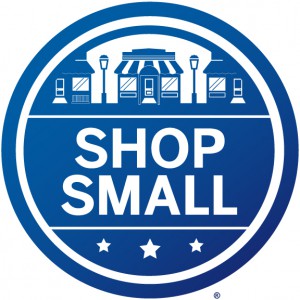 Small businesses have the power to propel local economies and uplift communities. When we shop small we’re supporting small businesses that create two out of three net new jobs and employ more than half of the country’s private workforce.
Small businesses have the power to propel local economies and uplift communities. When we shop small we’re supporting small businesses that create two out of three net new jobs and employ more than half of the country’s private workforce.
As the holiday shopping season begins, let’s recommit to honoring our neighborhood champions, America’s small businesses. Saturday, November 28, 2015 is Small Business Saturday® – a day to celebrate and support small businesses for all they contribute to our communities.
On that Saturday, let’s support jobs and economic growth in our own backyards. Visit your Main Street merchants to find unique, handmade gifts that you won’t find at a big-box retailer. Afterwards, dine small at your local restaurant to usher in the new tradition of supporting local eateries too. The restaurant industry employs 14 million Americans and generates $709.2 billion in sales, equal to 4 percent of the gross domestic product.
Shopping small packs a big punch to the U.S. economy. Last year, there were 88 million consumers “Shopping Small” on Saturday. 77% of consumers said Small Business Saturday® inspires them to “Shop Small” throughout the year and not just for the holidays. In addition, 66% of consumers state the main reason they support small businesses is because of their contributions to the community.
Main street businesses are critical to our nation’s success and supporting them during Small Business Saturday is an act of economic patriotism. To support the entrepreneurial spirit of small businesses, please join me and the U.S. Small Business Administration in shopping and dining small on Saturday – November 28.
For more information, check out: www.sba.gov/smallbusinesssaturday
Free Webinar: Using HealthCare.gov to Enroll in Health Coverage
 A live training webinar, “Using HealthCare.gov to Enroll in Health Coverage,” will be presented on Wednesday, December 9, 2015.
A live training webinar, “Using HealthCare.gov to Enroll in Health Coverage,” will be presented on Wednesday, December 9, 2015.
Register today for “Using HealthCare.gov to Enroll in Health Coverage”
- Start time: 2:00 p.m. (Eastern), 1:00 (Central)
- Duration: 60 minutes
- Speaker: Krista Das, Health Insurance Specialist with Centers for Medicare & Medicaid Services (CMS)
- Learning outcomes: If you haven’t applied for insurance on HealthCare.gov before, this webinar will tell you what you need to know about the Health Insurance Marketplace (sometimes known as the health insurance “exchange” or “Obamacare exchange”). Topics include:
- Who is eligible to use the Marketplace
- What plans cover
- What savings you qualify for based on your income, household, and state
- How to pick a plan category and compare plans
- The fee for not being covered
- How to apply and enroll in health coverage
- Expected level of knowledge for participants: No prerequisite knowledge required
The webinar is free, however registration is required. Upon registering, a confirmation email will be sent to you. This registration confirmation email includes the instructions for joining the webinar.
Registration confirmations will be sent from sqldba @ icohere.com. To ensure delivery of registration confirmations, registrants should configure junk mail or spam filter(s) to permit messages from that email address. If you do not receive the confirmation, please notify GPO.
GPO’s eLearning platform presents webinars using WebEx. In order to attend or present at a GPO-hosted webinar, a WebEx plug-in must be installed in your internet browser(s). Download instructions.
Visit FDLP Academy for access to FDLP educational and training resources. All are encouraged to share and re-post information about this free training opportunity with others.
The Modern Farm Horse
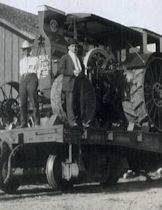 As the harvest season is ending, I thought it would be a great time to look at some of the first tractors Nebraskans used to work the fields. Looking at the photos in Nebraska Memories makes me wonder what people thought of these large metal machines as they started to be delivered to farms across the state. Someone in Sidney cared enough to have a photo taken of a railroad flat car loaded with three International Harvester Mogul steam tractors. You can see how large the tractors are compared to the men standing in front of them.
As the harvest season is ending, I thought it would be a great time to look at some of the first tractors Nebraskans used to work the fields. Looking at the photos in Nebraska Memories makes me wonder what people thought of these large metal machines as they started to be delivered to farms across the state. Someone in Sidney cared enough to have a photo taken of a railroad flat car loaded with three International Harvester Mogul steam tractors. You can see how large the tractors are compared to the men standing in front of them.
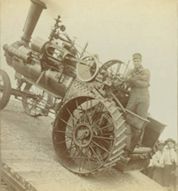 Photographer John Nelson took a picture of man who I consider to be brave. The man is standing on the back of a tractor that appears to be part way up a ramp with a sharp incline. The tractor must have great breaks since it is not rolling down the incline.
Photographer John Nelson took a picture of man who I consider to be brave. The man is standing on the back of a tractor that appears to be part way up a ramp with a sharp incline. The tractor must have great breaks since it is not rolling down the incline.
John Nelson also took a picture of a group of six men standing next to a tractor in what appears to be the middle of a field. While we may never know what was really going on at the time of this picture it appears to me that they got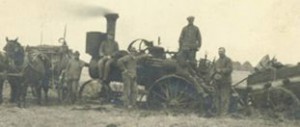 the tractor and the cart they were pulling stuck in the mud. As you can see, the back wheels of the tractor and the wagon wheels are almost axel deep in mud. You have to wonder if the tractor made it out on its own steam or if the men and/or horses in the picture had to help.
the tractor and the cart they were pulling stuck in the mud. As you can see, the back wheels of the tractor and the wagon wheels are almost axel deep in mud. You have to wonder if the tractor made it out on its own steam or if the men and/or horses in the picture had to help.
If you haven’t noticed, I don’t know much about tractors. When I saw the photo of the Hart-Parr Company, I just assumed it was a local company in Lincoln. I love the sign next to the garage door. It states “The modern farm horse. Does plowing for 40 to 60 cents per acre. eats nothing when idle”. 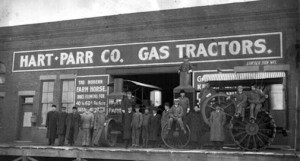
I originally planned to do a bit of research to see if I could learn something about this local company. I was surprised to learn however that the Hart-Parr Company was actually a tractor company based out of Charles City Iowa. I can only assume that the location in Lincoln was the local dealership. If you are a tractor enthusiast, you may be interested to know that Hart-Parr merged with three other companies in 1929 to form the Oliver Farm Equipment Company. The Oliver Company went through some changes and finally ended up being White Farm Equipment.
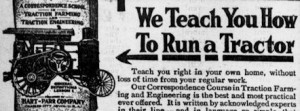 One of the place I looked for information about the Hart-Parr Company was in the Library of Congress’s Chronicling America: Historic American Newspapers collection. While I
One of the place I looked for information about the Hart-Parr Company was in the Library of Congress’s Chronicling America: Historic American Newspapers collection. While I  didn’t find the type of information I was hoping to find I did run across a couple of fun ads that appeared in The Commoner. In 1912 the Hart-Parr Company offered a correspondence course that would teach you how to run a tractor. Participants in the course also got to attend the practice schools where they could “actually run a tractor”. One of these schools was located in Lincoln.
didn’t find the type of information I was hoping to find I did run across a couple of fun ads that appeared in The Commoner. In 1912 the Hart-Parr Company offered a correspondence course that would teach you how to run a tractor. Participants in the course also got to attend the practice schools where they could “actually run a tractor”. One of these schools was located in Lincoln.
I hoped you enjoyed seeing some of these “Modern Farm Horse”. Visit Nebraska Memories to search for or browse through many more historical images digitized from photographs, negatives, postcards, maps, lantern slides, books and other materials.
Nebraska Memories is a cooperative project to digitize Nebraska-related historical and cultural heritage materials and make them available to researchers of all ages via the Internet. Nebraska Memories is brought to you by the Nebraska Library Commission. If your institution is interested in participating in Nebraska Memories, see http://nlc.nebraska.gov/nebraskamemories/participation.aspx for more information, contact Devra Dragos, Technology & Access Services Director.
New State Agency Publications Received at the Library Commission
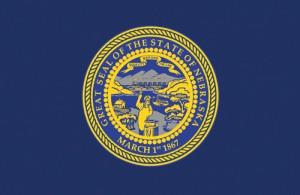 New state agency publications have been received at the Nebraska Library Commission for September and October, 2015. Included are titles from the Nebraska Crime Commission, the Nebraska Secretary of State, and University of Nebraska Press, to name a few.
New state agency publications have been received at the Nebraska Library Commission for September and October, 2015. Included are titles from the Nebraska Crime Commission, the Nebraska Secretary of State, and University of Nebraska Press, to name a few.
The Data Dude on Device Ownership
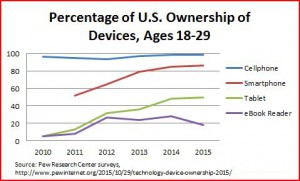 This week, there is yet another Pew Research Center study worthy of regurgitation (the Dude knows this is familiar territory). The report, titled Technology Device Ownership: 2015, details the rise and fall of ownership of devices such as cellphones, smartphones, desktop and laptop computers, tablet computers, game consoles, MP3 players, and eBook readers. While the chart at the right details the specific 18-29 age demographic, those numbers (and trends) mirror the general population (GP). It should come as no surprise that smartphone and tablet computer ownership is on the rise and eReaders, portable gaming devices, and MP3 players are on the decline. It’s fairly easy to understand the reasons for the trend, but in case you might be having trouble the Dude will spell it out for you. The reason is that eReading, game playing, and music listening can just as effectively be done on devices that not only handle those specific functions but do others as well (or multi-taskers, if you will). Example: A smartphone makes phone calls but also can handle your MP3 music files, so if you are out for a stroll and want to listen to some tunes, no need to pack up that MP3 player and AA batteries. Just take the phone. Likewise if you want tunes in your car (and have a more modern car), just plug the phone in. Gone are the days of burning your own CD’s (or cassette tapes); just drag and drop them ol’ MP3’s on your phone and plug it in to the AUX jack on the modern vehicle. If you’ve got a non-modern car, play it old school and turn on the radio.
This week, there is yet another Pew Research Center study worthy of regurgitation (the Dude knows this is familiar territory). The report, titled Technology Device Ownership: 2015, details the rise and fall of ownership of devices such as cellphones, smartphones, desktop and laptop computers, tablet computers, game consoles, MP3 players, and eBook readers. While the chart at the right details the specific 18-29 age demographic, those numbers (and trends) mirror the general population (GP). It should come as no surprise that smartphone and tablet computer ownership is on the rise and eReaders, portable gaming devices, and MP3 players are on the decline. It’s fairly easy to understand the reasons for the trend, but in case you might be having trouble the Dude will spell it out for you. The reason is that eReading, game playing, and music listening can just as effectively be done on devices that not only handle those specific functions but do others as well (or multi-taskers, if you will). Example: A smartphone makes phone calls but also can handle your MP3 music files, so if you are out for a stroll and want to listen to some tunes, no need to pack up that MP3 player and AA batteries. Just take the phone. Likewise if you want tunes in your car (and have a more modern car), just plug the phone in. Gone are the days of burning your own CD’s (or cassette tapes); just drag and drop them ol’ MP3’s on your phone and plug it in to the AUX jack on the modern vehicle. If you’ve got a non-modern car, play it old school and turn on the radio.
Now eReading and game playing for most can both be accomplished with a small tablet computer. Forget about separate eReaders and game playing devices; just get one tablet that can handle both of these and many other functions (the price difference isn’t much). For some, games can also be played on the smartphone, depending of course on the game. It’s a bit better experience on the tablet, though, and why not pay a few extra dollars for the color tablet that allows you to download and play games? Because, let’s face it, if you’re like the Dude, you enjoys a bit of Pac Man 256 or Crossy Road now and again. When we think about eReaders, we typically think about basic black and white devices that you can’t do those things on, and you can’t really watch movies or stream video content on those B&W thingy’s. Finally, when looking at these trends ask yourself about your own websites. Are they optimized so that those viewing your site on a tablet or smartphone have a decent experience? Is the site accessible from such devices? It’s been said before and it’ll now be said again. Shaka.
Free Webinar on Veterans Health Information Resources
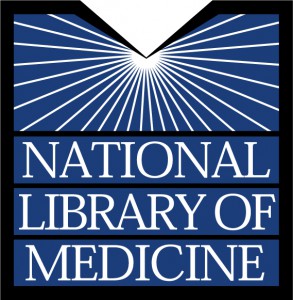 There are currently over 21 million veterans in the United States. They often face unique health care needs as a result of experiencing combat, exposure to environmental hazards, and separation from loved ones. This presentation will highlight some of their specific health concerns, and explore health information resources that would be beneficial for both veterans and their families. This webinar is geared towards those in public health, community-based organizations, community colleges, and public libraries who provide programs and services to veterans.
There are currently over 21 million veterans in the United States. They often face unique health care needs as a result of experiencing combat, exposure to environmental hazards, and separation from loved ones. This presentation will highlight some of their specific health concerns, and explore health information resources that would be beneficial for both veterans and their families. This webinar is geared towards those in public health, community-based organizations, community colleges, and public libraries who provide programs and services to veterans.
Instructions to connect to the audio will show up once you’ve logged in. No registration required. Captioning will be provided and the session will be recorded.
Wednesday, November 11, 2015 – 1:00PM MT/2:00PM CT
Join us at: https://webmeeting.nih.gov/mcr2
The Data Dude on Project Outcome
 For those of you that are still fizzed from NLA, you might want to check out the Public Library Association’s Project Outcome. Project Outcome began in January, 2015 as a 3 year project with funding from the Gates Foundation. It is a completely free resource. The idea behind Project Outcome is that it provides tools (meaning surveys given to library users that result in some flashy charts and graphs) to measure outcomes. An outcome is defined as: “a specific benefit that results from a library program or service designed to help patrons change their knowledge, skills, attitudes, behavior, or condition.” Now there are a lot of buzz words surrounding things like Project Outcome, so the Dude will summarize things by saying that Project Outcome is designed to be a simple tool to provide you with a snapshot of how your library is doing (and what you might need to improve on). The Project Outcome people say that the goal is to address the “need for better data to demonstrate the value of your public library programs and services.” The surveys are short (6 questions in length), and cover 7 different areas: civic/community engagement, digital inclusion, early childhood literacy, economic development, education and lifelong learning, job skills, and summer reading. You don’t have to do surveys for all of the areas; rather, you can pick and choose the ones you want.
For those of you that are still fizzed from NLA, you might want to check out the Public Library Association’s Project Outcome. Project Outcome began in January, 2015 as a 3 year project with funding from the Gates Foundation. It is a completely free resource. The idea behind Project Outcome is that it provides tools (meaning surveys given to library users that result in some flashy charts and graphs) to measure outcomes. An outcome is defined as: “a specific benefit that results from a library program or service designed to help patrons change their knowledge, skills, attitudes, behavior, or condition.” Now there are a lot of buzz words surrounding things like Project Outcome, so the Dude will summarize things by saying that Project Outcome is designed to be a simple tool to provide you with a snapshot of how your library is doing (and what you might need to improve on). The Project Outcome people say that the goal is to address the “need for better data to demonstrate the value of your public library programs and services.” The surveys are short (6 questions in length), and cover 7 different areas: civic/community engagement, digital inclusion, early childhood literacy, economic development, education and lifelong learning, job skills, and summer reading. You don’t have to do surveys for all of the areas; rather, you can pick and choose the ones you want.
For more information about the Project, here is the latest webinar, or this video contains an overview of the initiative. Shaka.
The Data Dude on the 2014 Digital Inclusion Survey Results
 Shaka. The results from the 2014 Digital Inclusion Survey are now available. Here is a link to the press release and a number of the reports. The Nebraska page can be found here. You can view the specific data and profile for your library by typing your library name in the search box (just make sure your browser is up to date if you have problems). Digital inclusion addresses both the digital divide and digital literacy. Thank you for your participation in last year’s survey (our response rate was much higher than the previous year). Here is a brief summary of how Nebraska compares to the national average on some of the digital inclusion areas (for a complete list, go to the link on the Nebraska page and scroll down):
Shaka. The results from the 2014 Digital Inclusion Survey are now available. Here is a link to the press release and a number of the reports. The Nebraska page can be found here. You can view the specific data and profile for your library by typing your library name in the search box (just make sure your browser is up to date if you have problems). Digital inclusion addresses both the digital divide and digital literacy. Thank you for your participation in last year’s survey (our response rate was much higher than the previous year). Here is a brief summary of how Nebraska compares to the national average on some of the digital inclusion areas (for a complete list, go to the link on the Nebraska page and scroll down):
2014 Digital Inclusion Survey Results
| Nebraska | National Avg. | |
| Avg. Download Speed | 10 Mbps | 16 Mbps |
| Avg. Number of Public Access Computers/laptops | 13.3 | 18.8 |
| eBooks | 79.1% | 90.3% |
| Online Health Resources | 38.8% | 76.8% |
| Mobile Apps to Access Library Services | 25.9% | 42.7% |
| General Computer Skills Training | 81.9% | 86.9% |
| General Familiarity with New Technologies (e.g. using eReaders, tablets) | 59.0% | 61.8% |
| Social Media (e.g. blogs, Twitter, FaceBook, YouTube) | 62.3% | 57.2% |
| Summer Reading for Children | 90.5% | 95.4% |
| GED or Equivalent Education | 20.9% | 34.9% |
| STEAM (Science, Technology, Engineering, Arts, and Math) Events | 20.4% | 34.2% |
| Applying for Jobs | 66.2% | 73.1% |
| Accessing and Using Online Business Information Resources | 26.4% | 47.9% |
| Providing Work Space(s) for Mobile Workers | 39.3% | 36.1% |
| Hosting Community Engagement Events (e.g., Candidate Forums, Community Conversations): | 32.8% | 40.2% |
| Hosting Social Connection Events for Young Adults (e.g., manga/anime, gaming, book groups): | 43.3% | 59.8% |
| Identifying Health Insurance Resources | 48.3% | 59.4% |
| Locating and Evaluating Free Health Information Online | 57.2% | 57.7% |
Protect Your Small Business Against Credit Card Fraud
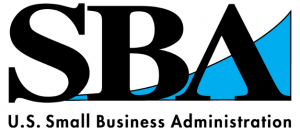 You’ve probably heard of people stealing, buying, and selling credit card information. You don’t want your business to be the victim of such a transaction. But on any given day, your small business is now vulnerable.
You’ve probably heard of people stealing, buying, and selling credit card information. You don’t want your business to be the victim of such a transaction. But on any given day, your small business is now vulnerable.
The cardholder’s issuing bank previously took care of these situations. Previously.
That’s the way it used to be. Now your small business could be the one that is liable–not the issuer. Starting October 1, the rules changed for Europay, Mastercard and VISA (EMV) cards. Now, there are “chip cards”, and U.S. credit card companies set October as the deadline for the national adoption of their new chip cards. So, if you have not integrated EMV technology that processes chip cards, your business will now become financially responsible for fraudulent transactions previously covered by the cardholder’s issuing bank.
Why are credit card companies taking this route? Roughly 90 percent of credit card terminals in Europe are chip-enabled. According to Barclays, the United Kingdom has seen nearly a 70 percent decline in counterfeit card transactions since making the transition. Meanwhile, America has 25 percent of the world’s credit card use, but 50 percent of the world’s credit card fraud, and that’s enough reason for card companies to demand a shift from antiquated swipe-and-sign to microchips on credit cards.
The U.S. Small Business Administration (SBA) is concerned that many U. S. entrepreneurs are still in the dark about this change. It is estimated that about 20 percent of our nation’s payment terminals are currently equipped to accept chip cards, but most of these are at larger retailers. This means the majority of America’s small businesses will need to upgrade their payment systems as soon as possible. Depending on the cost of the goods and services that a small business sells, being held liable for fraudulent card use could have serious financial consequences.
Most small businesses can’t afford their own fraud departments and definitely can’t afford to be behind the curve while large competitors move forward with technology upgrades. That’s why the SBA has partnered with Square to educate small businesses about how to increase your payment security and to protect cardholder information. Visit the SBA website www.sba.gov/emv to read all about the change to EMV (Europay, Mastercard, Visa) cards and what you need to do. You can learn how to prevent risk and protect both you and your customers against credit card fraud and the liability that comes along with it.
Reprinted from SBA Nebraska District Office news release received October 19, 2015.
Free Webinar –Marketplace.cms.gov: The Official Marketplace Information Source for Assisters and Outreach Partners
 A live training webinar, “Marketplace.cms.gov: The Official Marketplace Information Source for Assisters and Outreach Partners,” will be presented on Thursday, November 12, 2015.
A live training webinar, “Marketplace.cms.gov: The Official Marketplace Information Source for Assisters and Outreach Partners,” will be presented on Thursday, November 12, 2015.
Register today for “Marketplace.cms.gov: The Official Marketplace Information Source for Assisters and Outreach Partners”
- Start time: 2 p.m. (Eastern)
- Duration: 60 minutes
- Speakers:
- Maria Everette, Centers for Medicare & Medicaid Services (CMS), Content Manager, Marketplace.cms.gov
- Valerie Perkins, Centers for Medicare & Medicaid Services, Writer, Marketplace Consumer Products
- Learning outcomes: Marketplace.cms.gov is the official online Marketplace resource for assisters and outreach partners. During this webinar, CMS staff will present an overview of the information that’s available on Marketplace.cms.gov. The site provides information about assister programs and tools to help existing and new Health Insurance Marketplace consumers. The presentation will highlight the outreach and education section of the website, where users will find materials for consumers, resources for presentations, and promotional tools. The webinar will include a walkthrough of the site.
- Expected level of knowledge for participants: No prerequisite knowledge required.
The webinar is free, but registration is required. Upon registering, a confirmation email will be sent to you. This registration confirmation email includes the instructions for joining the webinar.
Registration confirmations will be sent from sqldba @ icohere.com. To ensure delivery of registration confirmations, registrants should configure junk mail or spam filter(s) to permit messages from that email address. If you do not receive the confirmation, please notify GPO.
GPO’s eLearning platform presents webinars using WebEx. In order to attend or present at a GPO-hosted webinar, a WebEx plug-in must be installed in your internet browser(s). Download instructions.
Visit FDLP Academy for access to FDLP educational and training resources. All are encouraged to share and re-post information about this free training opportunity with others.
2016 Health Care and Medicare Enrollment
It’s that time of year again–time to start thinking about signing up for or renewing your Medicare or Health Insurance. Enrollment for Medicare begins next week on October 15th, and Health Insurance enrollment begins November 1st.
 The Medicare.gov website is the official online resource for Medicare, and has all the information you or your patrons need to answer questions and to apply.
The Medicare.gov website is the official online resource for Medicare, and has all the information you or your patrons need to answer questions and to apply.
![]() The Healthcare.gov website is the official website for applying for, or changing, your healthcare insurance. The site gives step-by-step instructions, as well as answers many questions about the process.
The Healthcare.gov website is the official website for applying for, or changing, your healthcare insurance. The site gives step-by-step instructions, as well as answers many questions about the process.
SBA Awards $100,000 to GROW Nebraska to Support Native American Small Businesses
 The U.S. Small Business Administration (SBA) announced today that it has awarded $100,000 to GROW Nebraska for projects promoting the development, success, and long-term survival of Native American firms eligible for assistance under the SBA’s 7(j) Management and Technical Assistance Program. Project funding is provided by SBA’s Office of Native American Affairs.
The U.S. Small Business Administration (SBA) announced today that it has awarded $100,000 to GROW Nebraska for projects promoting the development, success, and long-term survival of Native American firms eligible for assistance under the SBA’s 7(j) Management and Technical Assistance Program. Project funding is provided by SBA’s Office of Native American Affairs.
The SBA grant program announcement sought unique and innovative proposals to provide specialized training, executive education, and tools to promote business development of Native American small businesses. This funding will help to address some of the challenges Native American firms and other 7(j) eligible firms face, including teaming with other businesses; mastering the process of federal contracting; and reversing declines and re-energizing small businesses.
GROW Nebraska will work with partners Lakota Hope and the University of Nebraska at Lincoln (UNL) Extension to capitalize on the talents and interests of entrepreneurs on the Pine Ridge Indian Reservation and in the Whiteclay, Neb., area to create a group of entrepreneurs who work together and support each other as they build scalable small businesses that will generate a livable income for the business owner and his/her family, create jobs, and have a positive impact on Reservation residents. With this grant, GROW Nebraska, Lakota Hope and UNL Extension will create an innovative, entrepreneur-focused program that builds and supports a powerful business strategy for each participant involved in the program.
To learn more about the SBA’s Office of Native American Affairs, please visit www.sba.gov/naa.
The Data Dude – OverDrive Data Prefilled on Survey
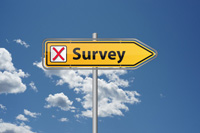 Just as the Dude was ready to start on a couple of rather extensive posts in response to some abstract concepts, he received a call from some overachievers who were compiling their OverDrive circulation data since their fiscal year has now ended. Actually, this was a good thing, because it led the Dude to revise the Bibliostat page of the NLC website and brought his attention to some material there that was just a tad outdated. The pages should now be up to date, but if you notice any errors, please let me know.
Just as the Dude was ready to start on a couple of rather extensive posts in response to some abstract concepts, he received a call from some overachievers who were compiling their OverDrive circulation data since their fiscal year has now ended. Actually, this was a good thing, because it led the Dude to revise the Bibliostat page of the NLC website and brought his attention to some material there that was just a tad outdated. The pages should now be up to date, but if you notice any errors, please let me know.
This reporting on the survey is always confusing. For one, the survey asks for “Children’s” circulation, but OverDrive doesn’t use that same terminology. It uses Juvenile and Young Adult. Some might disagree, but the survey instructions indicate that you include young adult titles with children’s, so that is where they are counted.
Here’s the good news: You don’t even have to open that guide if you don’t want to. For OverDrive, all these numbers, for both consortium holdings and OverDrive circulations (both adult and children’s) should be prefilled on your survey. In past years, this was the source of a lot of undue stress and confusion about how to get these figures and how to do the necessary math to fit them into both adult and children’s categories. Well, math no more; prefill is our friend. It should be noted that if you have another service other than OverDrive, get out your calculators because you will need to add those numbers to the prefilled amounts. And for those of you who have a subscription to eBooks or Audiobooks with a patron-driven acquisition model (that’s a fancy way of saying that your library has access to a massive collection of eBooks or Audiobooks and you only pay for what your patrons want to read/listen to), then you need to get a bit creative.
For these types of things (we’re talking eBooks, Audiobooks, or videos here) the key is whether or not they are “returned” or permanently retained. Keep in mind that downloading something to a device only to have it disappear after a set period of time is the same thing as returned. For these things, you count the number of items circulated both as holdings and circulations. In other words, if you have access to a service that has a catalog of 1,000,000 eBooks and during the course of your fiscal year there are 10,000 eBooks that are downloaded, then you count 10,000 for your eBook holdings and 10,000 added to your electronic materials circulation. If the items are retained and not returned, then you count those under electronic collections (in the technology part of the survey). There is a guide on the website that was originally created by the state data coordinator from Arizona, and tweaked for use in Nebraska. Shaka.

